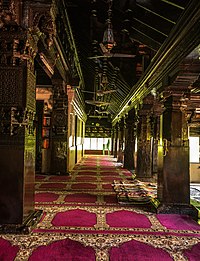Nawayath
This article needs additional citations for verification. (December 2017) |
The Nawayath (also spelled Navayath and Nawayat) are an Indian Muslim community concentrated mostly in the state of Karnataka, and in southern Maharashtra and some parts of Tamil Nadu. Some live in Madhya Pradesh and many migrated to Pakistan after independence in 1947 and predominantly settled in Karachi.
History
| Part of a series on |
| Islam in India |
|---|
 |
Jaffer Shariff (Qanoon-e-Islam), Colonel Wilkes (History of Mysore, vol 1), and the Imperial Gazetteer of India translate Nawayath as ‘New Comers’ (from Persian نوآید 'Nawāyad' which means newcomer). People from the Persia had established sustained trade relations with west coast of Arabian Sea since time immemorial. These authors are unanimous in their opinion that the Nawayaths are either of Persian stock but hold divergent opinions about their actual place of origin and the reasons for their exodus from the Persian Gulf. Colonel Wilkes states that the Nawayaths belong to the House of Hashem. In the early part of 8th century AD during the fearful reign of Hajaj bin Yusuf, the Governor of Iraq under the Caliph Abd-Al-Malik Marwan, many respectable and opulent persons fled Iraq fearing persecution. It is believed that they followed the route their fellow Arabs took for trade, anchoring on the west coast at several points. "While there may be some among the Nawayaths whose ancestry can be traced to those who fled Iraq during Hajaj bin Yusuf’s time not all ancestors are of that type", writes Victor D’ Souza in his book "Navayaths of Kanara"(1955).
SK Lal writes in the "Legacy of Arab Dynasty in India" that although Hajaj bin Yusuf was only the Governor of Iraq his influence and rule extended even to Persian speaking regions. Thus the Arabs and Persian traders carried on their commerce together, resulting in Persian influence in the coastal Indo-Muslim colonies.
Another theory relates Nawayaths to Iranians based on the influence of the Persian language on the language spoken by the Nawayaths and Persian elements in Navayaths culture, there is also the presence of an Iranian graveyard in bhatkal and most of the surname are Iranians which can be traced back to Iran even today.
Nawayats are migrants predominantly from Iran,who married into another trading community of India, the Jains who had been converted to Islam more than 1,000 years ago.[1][2] With this a new caste system emerged.[3]
The Mukri family for example settled in Musalman wadi, Ratnagiri . They trace their migration from Fez Morocco and Hadhramaut Yemen. The Mukris were Shafi Muslim scholars who fled Shia resistance in the 1400's after the fall of the Rasulid dynasty. The Mukri Koknanis speak a distinct Rajapuri dialect of Dakhani Hindustani.
The Indian historian Omar Khalidi says they are one of three groups of Indian Muslims who have used the Nawayarh name. These groups have common origins in the Arabian Peninsular and Persian Gulf regions, where they were mariners and merchants. and that they have also been called Nait, Naiti, Naita.groups is based mainly in the Bhatkal, Tonse, Malpe, Kandlur - Karnataka, while another is nowadays found in Chennai around Royapettah who have moved from Meenambur, a small village located between Gingee and Villupuram in the Villupuram District in the State of Tamil Nadu. A third group are generally known today as Konkani Muslims, after the region in which they live

